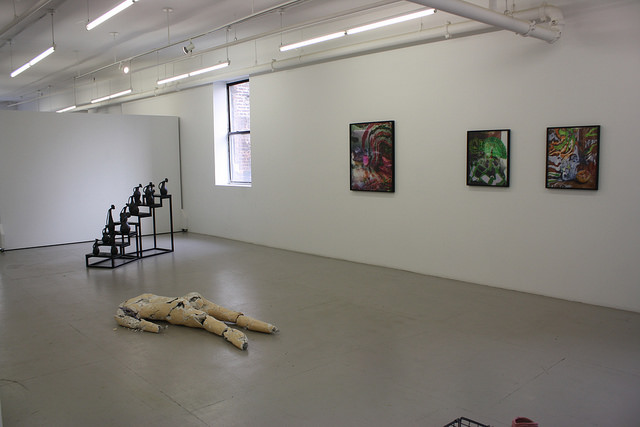
At Company Gallery, a prone crash dummy serves as the centerpiece. Are those watering cans ascending the stairs to look out the window or commit mass-suicide?
Michael: It’s always a surprise to see a group show, think you “get it,” and then read the curator’s statement and realize you’re totally off. That was my experience of almost everything we saw. That’s rewarding in its own way, though. And it gives me optimism that there are artists and curators veering away from the obvious, overly referential, and aesthetically homogeneous. So much of the work up in the LES right now has little in common from a stylistic or material perspective—leaving the viewer to make connections based largely on emotional impact. The fact that we all drew such different conclusions about the work might point to some unspoken, subconscious zeitgeists of concerns, desires, or points of reference. Looking for those is—in part—our jobs. So it’s nice when group shows are a little opaque.
Corinna: Feelings. So many feels were on display in the art on this LES trip. And I don’t know what to do with all of those feels in this humid swamp of a New York City July, when emotions only involve evading the sweatland. The most common emotion is “I have evolved into a fish. Must throw myself into the ocean.” But at Soft Core, I saw work that, while, yes, opaque, I wanted to see more. Adam Parker Smith is always a chameleon, and I never know what he’ll make, although it’s usually very tactile, and made to be looked at more than once. Close to the Skin, a show similarly bringing about feelings from non-human objects, hit the mark when the works were erotic. Otherwise, the relationship to these objects was…well, I don’t know. I do think there’s an urgency in art now to explore how non-human objects (whether technological or organic) can act on their own, without our intervention. And for that, these shows both took my interest.
Soft Core
Artists: Josh Blackwell, Anne Doran, Andrew Guenther, Dave Hardy, Karen Heagle, Christian Holstad, Stephen Irwin, Linder, William J. O’Brien, Suzannah Sinclair, Adam Parker Smith, Naomi Uman, Pinar Yolacan, and Jade Yumang
INVISIBLE-EXPORTS
89 Eldridge Street
New York, NY 10002
Summer hours: Wednesday through Saturday, 11:00 a.m. – 6:00 p.m.
Michael: The show is loosely organized around the idea of soft-core pornography or things that are literally “soft.” I’m more interested in the unstated references to prehistoric aesthetics and their relation here to somewhat base impulses: play, drawing a dick, making a mess, et cetera…There seems to be a lot of interest in primitivism and the libertine, but those are such loaded topics I can understand an aversion to addressing them head-on.
Michael: I love this. It reminds me of the paper cut-outs Matisse (patron saint of Primitivism) made later in life, but it’s full of cartoon-y boners and text like “SCUM” and “PISS” like a back patch you’d see on St. Marks. Felt also has that dual association with the primal and crafting supplies. I like how decor-friendly the piece is too. I could totally see this subversively slipping into some interior-decorator-designed condo or hotel lobby until someone actually looked at it.
Corinna: Right. Those details would surely be missed by most hotel-goers. It’s so soft, and such a jumble when you see it, though. There’s no depth, so it reminded me of a quilt. I don’t know if that’s a failure: I see the messiness of the work as being a “fuck you” to primitivism, to craft, by overloading it with images to the point of unreadability—except for the actual words, like “garbage,” “piss,” and “fucking.”
Michael: This is one of my favs of the day. It’s like a cave drawing on a plushy cut pile rug—seemingly drawn with the artist’s fingers. Of course, cave paintings have lasted millennia, but this would disappear if you vacuumed it. It reminded me of playing on the floor as a child. Mostly, I wanted to run my hands through it.
Corinna: Yeah, I loved how temporary it seemed, and plush. I wanted it, but only to know that I can’t have it.
Corinna: What is with all these references? I guess it’s better than the all-Greek phase we had around the time of VVORK? But there’s still that hyperlink/Photoshop blue in the background, “grounding” us in the present.
Michael: Again, I saw a Paleolithic art history reference here. I first thought this was a painting of a statuette like the Venus of Willendorf, but up-close it’s revealed that it’s a photo of a model in white body paint. I love that. I was confused as to why the head was cropped at first (a big no-no in the politics of representing female nudes) but that absence of face is totally necessary for the illusion to succeed. It’s not objectifying the model—it’s about referencing an iconic archetype that’s present in dozens of cultures’ old-school art history.
Corinna: Whoa. No idea that was a model.
Corinna: It’s fair to say there’s a system to this chaos. I like that—it’s such a fragile work, but maybe not? Like those Richard Serras that bend, and you’re not sure how they stay in the ground (usually the magic isn’t really magic—there’s some structure holding it down).Michael: I’m not too crazy about this. In the context of the other work, it does read like an archetypal column/spire/obelisk/monument to the child-like impulse to build a blanket fort. But mostly, I’ve just seen so much stacked stuff recently, so I’m a little bored. Why are sculptors so into Jenga lately? If its a monument to anything, it’s the artist’s balancing skills. I do like that chrome chair though.
Close to the Skin
Artists: Talia Chetrit, Marie-Ange Guilleminot, Elizabeth Jaeger, Life After Life (Karthik Pandian and Paige K. Johnston), and Willa Nasatir
Curated by Lumi Tan
Company Gallery
88 Eldridge Street, 5th Floor
New York, New York 10002
Summer hours: Wednesday through Sunday, 12:00 – 6:00 p.m.
Michael: This show threw me for a loop. Based on the title, and the anthropomorphic qualities of some of the work, I assumed it was about representing surrogate experiences of the body—from a sad-looking painting in a cage to weird watering can/flower vase figures leaning up a staircase toward the window. I found myself reading the “body language” of inanimate objects and empathizing. Perhaps that has to do with the sensibilities of Lumi Tan, who curates at The Kitchen, a performance-centric art space. What was the actual theme? “The subjectivity of smelling” or something?
Corinna: I ended up marking up the press release because I was trying to find the theme. Which isn’t so much about smelling—although that’s definitely in the PR—as much as, my favorite sentence that hints at what the exhibition is about: “Winking emoticons and a jokey affect ease the embarrassment of sharing personal opinions on the abject, the sexual, and the moments where our own bodies become overtly natural.” It’s about what’s too personal, and those hard to share “too personal” moments. But for me, the show was about human and non-human relations. But that shattered body on the floor was too literal—did not do it for me.
Michael: This is a weird one… I think I like it. My gut reaction was to feel bad for the dog, which is odd because I probably wouldn’t give that painting a second glance if it were in a frame rather than a cage.
Corinna: The painting reminds me of what Camille Henrot does with her line work, often focused on animals. I’m going to put myself out there and say that it’s sad that the dog is caged in, but I doubt that’s a worse proposition than being put up on a wall. My one issue with the work is that darn vase. It’s like you put a vase on it so that it’s art.
Michael: But I like the vase as a strategy for grounding this in the realm of sculpture. Otherwise, it’s a painting framed in a cage. It’s gimmicky, sure, but it seems like an invitation to interact with the work (even though I know you’re not supposed to literally). Like, this is a thing that can be picked up and used—it exists outside the realm of representation. And I think that makes the whole piece seem more “real.”
Michael: This is a video of a figure manipulating a shapeless sack, installed on a small monitor. At the point in the loop that we walked in, it looked so much like a scrotum being violently massaged. Then it goes through a progression of forms that read like udders being milked or bread being kneaded. I almost wish it didn’t have sound—you can hear that it’s a beanbag or filled with plastic beads. I liked the ambiguity of the material before I picked up on that.
Corinna: I loved this video. Marie-Ange Guilleminot made “dolls” and in this video her care for them borders on the erotic: I thought she might have been masturbating with them. If you care for an object, if you love it, it’s sometimes an erotic relationship. She goes there. I’m also reminded of the early work of Annette Messager, who dressed up her “boarders,” these dead, taxidermied birds who she knitted colorful sweaters for, and wrote detailed stories about them, too. (When I first saw these birds in sweaters, on a projection screen in an art history class, they looked like ice cream cones.)
Here’s some examples of Guilleminot’s “dolls,” below, just for reference.

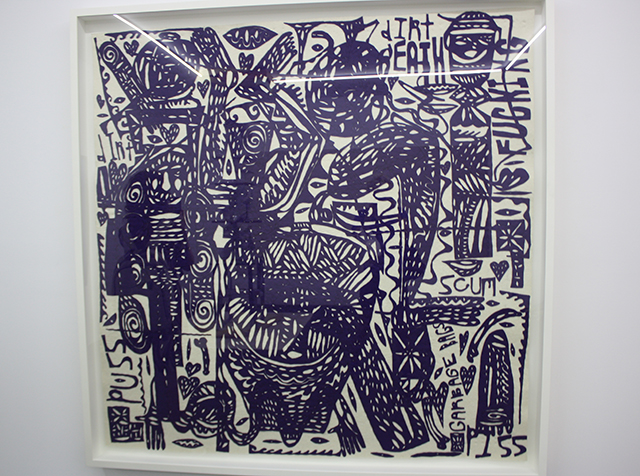
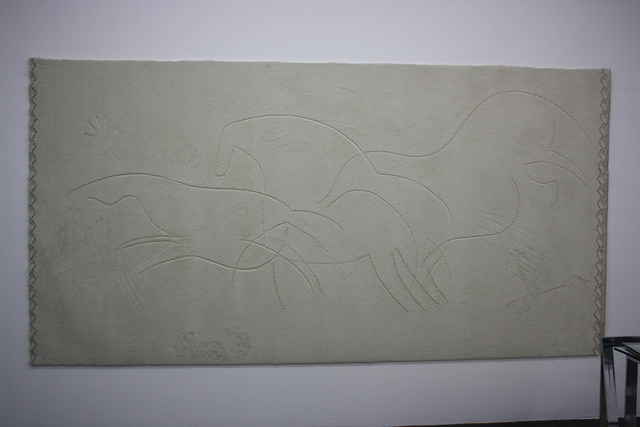
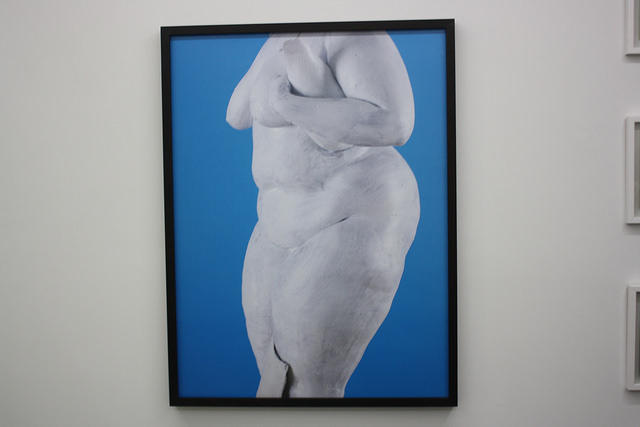
![Dave Hardy, [not yet titled], 2015.](http://artfcity.com/wp-content/uploads/2015/07/DH15-1.jpg)
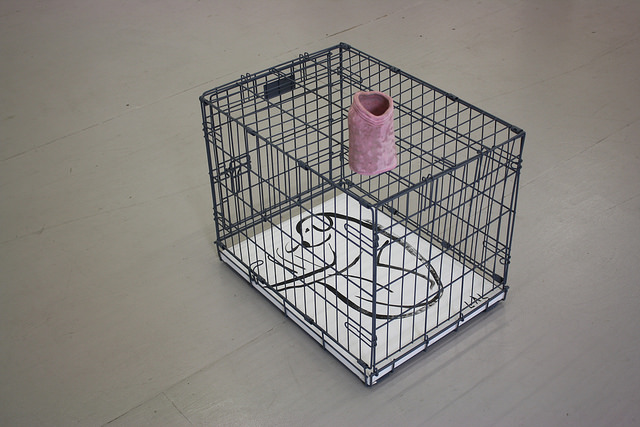
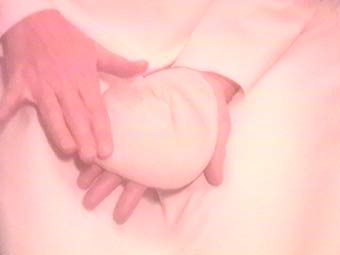

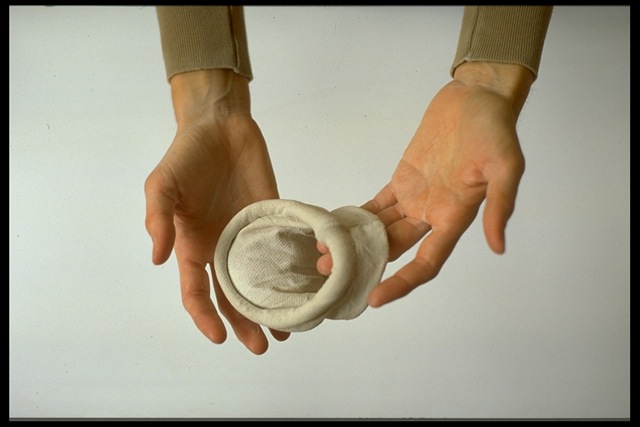

Comments on this entry are closed.